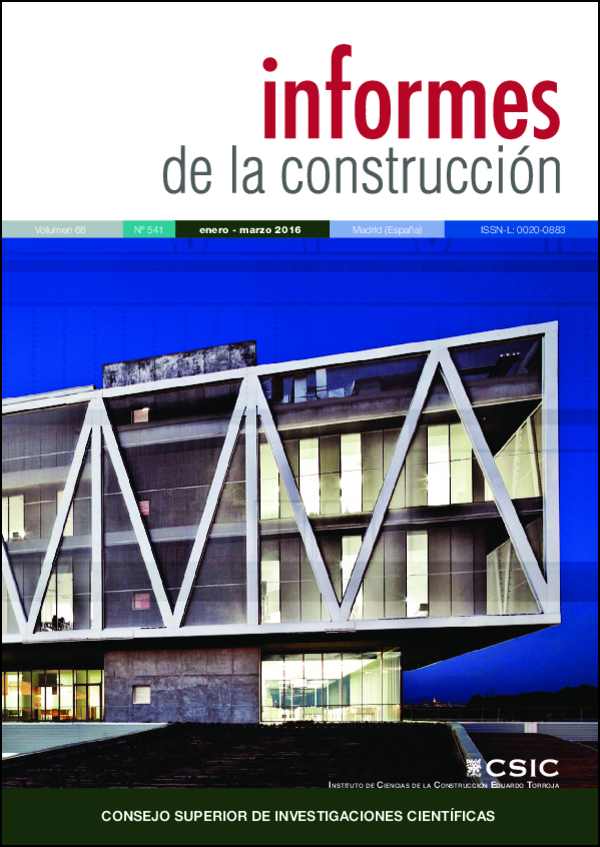Typological characterization of built space of corridor houses. The case of “ciudadelas” of the historic town in Havana and the corridor houses in Madrid
DOI:
https://doi.org/10.3989/ic.15.036Keywords:
Ciudadelas, corridor houses, typological characterization, typological invariantsAbstract
In this article, some of the results obtained from an investigation aiming to characterize the different models that in Spain and Spanish America developed from original “corridor houses” are presented. This research aims to design valid solutions allowing the adaptation of these houses to habitability current criteria. Specifically, results obtained from the characterization resulting from: date of building, dimensions and shape, and type of the yard and its relationship with corridors in 286 “corridor houses” in Embajadores neighborhood, in Madrid, and 213 so called “ciudadelas” inside the Historic Centre in Havana, are presented. As a conclusion, great coincidences have been found in both of the models. So that, it can be said that this is about a typological model, characteristic of ancient and popular neighborhoods, with such a high presence that it turns out impossible to explain the urban weave without considering their fundamental role in “filling” blocks.
Downloads
References
(1) Santa Cruz Astorqui, J. (2012). Estudio tipológico, constructivo y estructural de las casas de corredor de Madrid (Tesis Doctoral). Madrid: Escuela Universitaria de Arquitectura Técnica - Universidad Politécnica De Madrid.
(2) Ortiz Sanz, J., Rego Sanmartín, T., Cañas Guerrero, I. (2001). La Casa de Corral: Emblema de las construcciones agrarias tradicionales en Castilla León. Valladolid: Junta De Castilla y León - Consejería De Agricultura Y Ganadería.
(3) Piñera Entralgo, L.M. (2007). Ciudadelas, patios, callejones y otras formas similares de vida obrera en Gijón (1860-1960). Gijón: Ayuntamiento De Gijón.
(4) Carloni, A. (1984). La mujer en el corral de vecinos sevillano. Revista Etnografía Española, (4): 209-281.
(5) Fernández Martín, R. (2016). Inventario morfológico de las ciudadelas del casco histórico de La Habana para su caracterización como tipología específica. Estudio comparado con las corralas madrileñas (Tesis Doctoral). Madrid: Escuela Técnica Superior de Edificación - Universidad Politécnica de Madrid. PMCid:PMC4760708
(6) López Rodríguez, F., Rodríguez Roodríguez, V., Santa Cruz Astorqui, J., Torreño Gómez. I. (2003-2004). Estudio urbanístico y constructivo de las casas de corredor en Madrid. Investigación y documentación de las tipologías edificatorias y constructivas de las denominadas «Casas De Corredor» o «Corralas» en la ciudad de Madrid a partir de una relación de edificios proporcionada por la Empresa Municipal de la Vivienda (EMV). Trabajo de investigación realizado para la EMV y el COAATM. Madrid: Universidad Politécnica de Madrid.
(7) IBM. Software SPSS. http://www-01.ibm.com/software/es/analytics/spss/.
(8) Menéndez García, M. (2006). Tipología de la arquitectura doméstica del centro histórico La Habana Vieja. Su aplicación a los programas de rehabilitación (Tesis Doctoral). Ispjae: Facultad de Arquitectura.
(9) Coca García, O. (2003). La Ciudadela. transformación y desarrollo. Revista Arquitectura y Urbanismo, 24(2).
(10) Zardoya Loureda, M.V. (2003). La Ciudadela Habanera. Antecedentes Históricos. Revista Arquitectura y Urbanismo, 24(2).
Published
How to Cite
Issue
Section
License
Copyright (c) 2016 Consejo Superior de Investigaciones Científicas (CSIC)

This work is licensed under a Creative Commons Attribution 4.0 International License.
© CSIC. Manuscripts published in both the print and online versions of this journal are the property of the Consejo Superior de Investigaciones Científicas, and quoting this source is a requirement for any partial or full reproduction.
All contents of this electronic edition, except where otherwise noted, are distributed under a Creative Commons Attribution 4.0 International (CC BY 4.0) licence. You may read the basic information and the legal text of the licence. The indication of the CC BY 4.0 licence must be expressly stated in this way when necessary.
Self-archiving in repositories, personal webpages or similar, of any version other than the final version of the work produced by the publisher, is not allowed.















